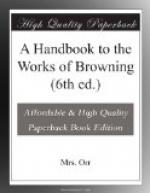“One Way of Love.”
(Love as the completeness of
self-surrender.) “Dramatic
Lyrics.” Published in “Men and
Women.” 1855.
“Rudel to the
Lady of Tripoli.” (Love as the completeness of
self-surrender.) “Men
and Women.” Published in “Dramatic
Lyrics.” 1842.
“In Three Days.”
(Love as the intensity of expectant hope.)
“Dramatic Lyrics.”
Published in “Men and Women.” 1855.
“In a Gondola.”
(Love as the intensity of a precarious joy.)
“Dramatic Romances.”
Published in “Dramatic Lyrics.” 1842.
“Porphyria’s
Lover.” (Love as the tyranny of spiritual
appropriation.) “Dramatic
Romances.” Published in “Dramatic
Lyrics.” 1842.
“James Lee’s
Wife.” (Love as saddened by the presentiment
and
the consciousness of
change.) “Dramatis Personae.” 1864
“The Worst of
it.” (Love as the completeness of
self-effacement.) “Dramatis
Personnae.” 1864.
“Too Late.”
(Love as the sense of a loss which death has
rendered irrevocable.)
“Dramatis Personae.” 1864.
The two first of these are inspired by the belief in the distinctness and continuity of the soul’s life; and represent love as a condition of the soul with which positive experience has very little to do; but in all the others it is treated as part of this experience, and subject for the time being to its laws. The situation sketched—for it is nothing more—in “CRISTINA” is that of a man and woman whom a glance has united, and who both have recognized in this union the predestined object of their life. The knowledge has only flashed on the woman’s mind, to be extinguished by worldly ambitions and worldly honours; and for her, therefore, the union remains barren. But the existence of the man is enriched and perfected by it. She has spiritually lost him, but he has gained her; for though she has drifted away from him, he retains her soul. (This poetical paradox is the strong point of the poem.) It is henceforth his mission to test their blended powers; and when that has been accomplished, he will have done, he says, with this world.
“EVELYN HOPE” is the utterance of a love which has missed its fruition in this life, but confidently anticipates it for a life to come. The beloved is a young girl. The lover is three times her age, and was a stranger to her; she is lying dead. But God, he is convinced, creates love to reward love: and no matter what worlds must be traversed, what lives lived, what knowledge gained or lost, before that moment is reached, Evelyn Hope will, in the end, be given to him.
“LOVE AMONG THE RUINS” depicts a pastoral solitude in which are buried the remains of an ancient city, fabulous in magnificence and in strength. A ruined turret marks the site of a mighty tower, from which the king of that city overlooked his domains, or, with his court, watched the racing chariots as they encircled it in their course. In that turret, in the evening grey, amidst the tinkling of the sheep, a yellow-haired maiden is waiting for him she loves; and as they bury sight and speech in each other’s arms, he bids the human heart shut in the centuries, with their triumphs and their follies, their glories and their sins, for “Love is best.”




